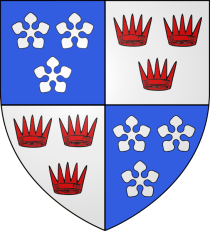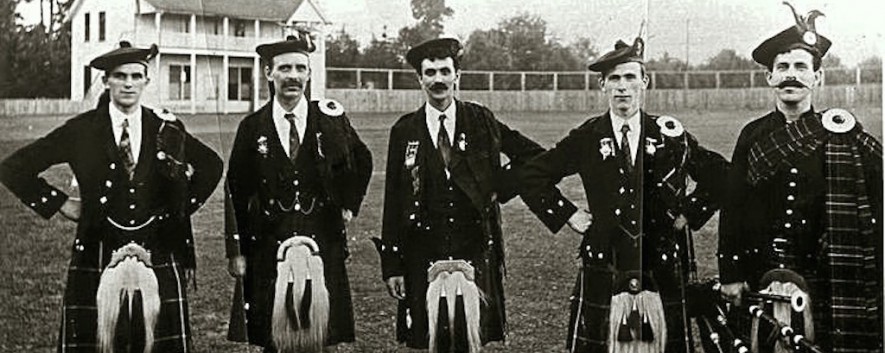At press time, Georgia Twiss was in her final semester of her undergraduate (honours) History degree at Simon Fraser University. Her research focuses on the impact of the British Empire on the urban development of Glasgow, and the legacy of imperialism within Glaswegian heritage, as well as performances of gender, culture, and imperialism in British Columbia. The basis of this research blog was a poster presentation for Georgia’s History honours seminar class in Spring 2018.
—
On September 9th 1965, Simon Fraser, 15th Lord Lovat, Chief of Clan Fraser of Lovat, took to the stage in Convocation Mall to give a speech commemorating the opening ceremonies of Simon Fraser University. He began his speech with a quote taken from Shakespeare proclaiming, “I didn’t come here to talk.”[1] His choice of words rang true. He was not there to talk, but to embody an invented tradition of Scottishness, promoted by the university’s President, Patrick McTaggart-Cowan, and predicated upon SFU’s association to the Clan Fraser of Lovat. While today most people assume the university’s name and Scottishness honour Simon Fraser, the nineteenth-century imperial explorer and fur trader, McTaggart-Cowan’s invented tradition intentionally excluded him in favour of Lord Lovat. As the head of the Clan, this Simon Fraser symbolized a prestigious sense of historical continuity and heritage that was lacking in the locally-branded “Instant University.”[2] It was through this invented tradition that the early university endorsed and enforced an image of SFU as overtly Scottish. An image which, despite contestation, has prevailed through the years, but in truth has little to do with Simon Fraser the Explorer at all.

[Figure 1] Lord Lovat bestowing the Clan Fraser Claymore (Not the mace as the caption of the photo suggests) to SFU at the university’s opening ceremonies, September 9th 1965.
The naming of SFU was a fluke by way of an acronymic oversight. The original name, ‘Fraser University’, was chosen to reflect the region from where its student body would largely derive. However, upon the realization that the school would be colloquially referred to as “F.U,” the prefix “Simon” was added, with no direct statement as to whom it was meant to honour.[3] This addition transformed the intended toponymic name to one that allowed for the forging of a relationship between the university and the Clan Fraser of Lovat, whose Chief at the time was named Simon Fraser. The relationship between SFU and the Clan began when Patrick McTaggart-Cowan, a Scottish immigrant to Canada himself, requested the use of the Clan’s motto and crest for the university’s insignia.[4] It was this relationship that underpinned McTaggart-Cowan’s invention of a Scottish tradition at SFU.

[Figure 2] “Coat of Arms.” Simon Fraser University.

[Figure 3] FRASER, Lord Fraser of Lovat Quarterly, 1st and 4th, Azure, three fraises (cinquefoils), Argent (for Fraser); 2nd and 3d, Argent, three antique crowns, Gules (for the Lordship of Lovat).
“Invented tradition” is a concept brought forth by historians Eric Hobsbawm and Terrence Ranger, and defined as, “a set of practices…of a ritual or symbolic nature, which seek to inculcate certain values and norms by repetition, which automatically implies continuity with the past.”[5] The invented tradition of SFU, through the appropriation of Clan Fraser of Lovat heritage, projects an image of historical Scottishness. The Clan’s imagery are found in SFU’s official tartan, coat of arms, and motto as well, as in the use of the ceremonial claymore and mace at formal ceremonies and events.

[Figure 4] “Patrick McTaggart-Cowan (left), flanked by B.C. Premier W. A. C. Bennett and SFU Chancellor Gordan Shrum, delivers SFU’s opening address on Sept. 9, 1965”
McTaggart-Cowan’s invented Scottishness was an attempt to formulate a shared identity for the incoming student body. This identity, centred around the prestige and history of the Clan Fraser of Lovat, would allow students to feel pride in their new university. McTaggart-Cowan’s plan however, backfired when met with reality. Rather than accepting this imposed Scottishness, SFU’s new students challenged the invented tradition in order to embrace the modern and progressive identity they saw in the divergent image of the “Instant University.”

[Figure 5] Clan Fraser of Lovat Clan Crest

[Figure 5] “The SFU Pipe Band has bagged the title of world champions six times. Now it’s ready to take New York, after a stage show here at home.”
The conflict between the two identities, apparent in the fall of 1965, was soon overtaken by more pressing issues such as enrollment fees and unionization. It would resurface again in 1968 when a student led movement to rename the school “Louis Riel University” was voted down.[11] Despite the disappearance of the figure of Lord Lovat from the university, McTaggart-Cowan’s invented Scottish tradition prevails. By exploring the construction of SFU’s Scottish image it becomes clear that the history of the university, from the beginning, has been a tale of two “Simon Frasers.” Not only the two competing figures of Simon Fraser of Lovat and Simon Fraser the Explorer, but the two divergent identities of instant and invented and the way they continue to shape the legacy and image of the university today.
© Georgia Twiss
Sources
[1] Quoted in: Hugh Johnston, Radical Campus (Vancouver: Douglas & McIntyre, 2005), 113.
[2] Built in just 18 months, the local press nicknamed the then unnamed university the “Instant University” before it became Simon Fraser University.
[3] Ceremonies and Events Office Fonds, 1963-1969. F-91-1-0-0-1. SFU Archives, Burnaby, BC, Canada.
[4] Lord Lovat, 1965-1995. F-208-1-0-0-5. SFU Archives, Burnaby, BC, Canada.
[5] Eric Hobsbawm and Terence Ranger, The Invention of Tradition (Cambridge: Cambridge University Press, 1992),
[6] Johnston, Radical Campus, 113.
[7] The Tartan and SF View: Issues, 1965. F-17-6-2. SFU Archives. Burnaby, BC, Canada.
[8] Ibid.
[9] The Peak: Issues, 1965-2016. F-17-6-3. SFU Archives. Burnaby, BC, Canada.
[10] The Peak (Burnaby, BC) October 20, 1965.
[11] McLeod, Brad. “Simon Fraser vs Louis Riel.” The Peak (Burnaby, BC) January 6, 2015.
Images
[Figure 1] “Lord Lovat and the SFU Mace.” Photograph. [Untitled.] Burnaby, BC, 1965. Accessed on November 13, 2018. https://www.flickr.com/photos/sfupamr/21097595415/in/photostream/
[Figure 2] “Coat of Arms.” Simon Fraser University. Burnaby, BC. Accessed November 13, 2018. https://www.sfu.ca/communicators-toolkit/tools/brand-tools/logos/coat-of-arms.html
[Figure 3] https://www.scotclans.com/scottish-clans/clan-fraser-of-lovat/fraser-of-lovat-coat-of-arms/ <accessed 14 November 2018>
[Figure 4] “Patrick McTaggart-Cowan (left), flanked by B.C. Premier W. A. C. Bennett and SFU Chancellor Gordan Shrum, delivers SFU’s opening address on Sept. 9, 1965” [Untitled.] Burnaby, BC, 1965. Accessed, November 13, 2018. https://www.sfu.ca/sfunews/stories/2016/founding-president-patrick-mctaggart-cowans-sfu-legacy.html
[Figure 5] Clan Fraser of Lovat Clan Cresthttps://www.scotclans.com/scottish-clans/clan-fraser-of-lovat/fraser-of-lovat-crest/ <accessed 14 November 2018>
[Figure 6] “The SFU Pipe Band has bagged the title of world champions six times. Now it’s ready to take New York, after a stage show here at home.” Meadahl, Marianne. [Untitled.] Photograph. Victoria, BC, 2014. Accessed November 13, 2018. https://the-peak.ca/2014/05/sfu-pipe-band-prepares-for-the-world-stage/

Pingback: Canadian History Roundup – Weeks of November 11 and 18, 2018 | Unwritten Histories